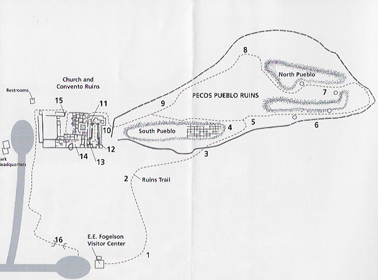
Location
1. Behind the south wall at the Visitor Center (GPS - N35D32'59.862 X W105D41'20.957)
2. Throughout the trail
Flowers first observed: 4/3/17
The Plant

The Plant w/Flowers

The Flower

Distribution
"NV, UT, and AZ, east to KS, OK, and TX; south to MEX. Notes: Erigeron is a difficult genus, with many similar looking species distingushed from each other by subtle and obscure characters. A hand lens is necessary for field ID, and making a collection is generally advisable in order to have any confidence in a determination. Identify the genus as a whole from its characteristic daisy-like flowers with white to pale purple rays and yellow centers (although a few species have extremely small rays); involucres with 2-5 series of phyllaries, all about the same length (subequal); and tufts of bristles on the tops of the seeds. E. tracyi is quite similar to the common and widespread E. flagellaris; E. tracyi can be distinguished by the denser spreading hairs on its stems and flower stalks (E. flagellaris has appressed hairs); its slightly woody base; and the fact the stolons rarely root at the tips." (SEINet)
Description
"Erigeron tracyi combines characteristics of Erigeron divergens and Erigeron flagellaris. The overall appearance of the plant is that of the former and the stolons (runners) are similar to those of the latter. A Utah Flora and Intermountain Flora consider E. tracyi to be a variety of E. divergens, but The Flora of North America, the Synthesis, and Weber consider E. tracyi to be a distinct species. Erigeron trayci certainly has a number of characteristics that are distinct from those of E. divergens: E. trayci is often perennial; E. divergens is annual. E. trayci has long and obvious stolons; E. divergens does not have stolons."
(Text from (https://www.swcoloradowildflowers.com)
Ethnobotanical Uses
Unknown, but other species in the genus have uses:
Medicine:
"Thompson Analgesic Salve of toasted, crushed plant and grease rubbed on painful area. Decoction of plant taken for backache, stomachache, or menstrual cramps. Dermatological Aid Salve of toasted, crushed plant and grease rubbed on painful swollen areas. Toasted, powdered stems and leaves sprinkled on sores, ulcers, cuts and wounds. Gastrointestinal Aid Decoction of plant taken for stomachache. Gland Medicine Salve of toasted, crushed plant and grease rubbed on swollen glands. Gynecological Aid Decoction of plant taken for menstrual cramps. Throat Aid Salve of crushed plant used on throat or plant chewed for sore throat."(Moerman 219)
"Navajo, Ramah Ceremonial Medicine Cold infusion of leaves used ceremonially as a medicine and as a fumigant. --- Dermatological Aid Poultice of chewed leaves applied to spider bites and used as a hemostat. --- Disinfectant Cold infusion of leaves used ceremonially for 'lightning infection.' --- Hemostat Poultice of chewed leaves applied as a hemostatic. Snakebite Remedy Compound poultice of plant applied to snakebite. Veterinary Aid Cold infusion of leaves used as eyewash for livestock. ---" (Moerman 218)
Other Uses:
"Fiber - Keres, Western Brushes & Brooms Tied bunches of plants used for brooms. ---" (Moerman 218)
Internet Links